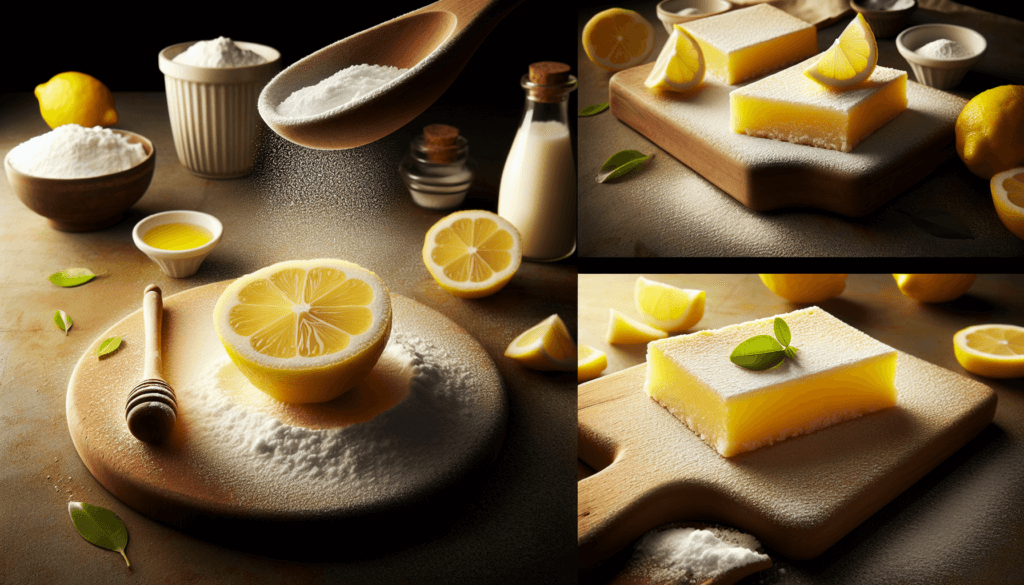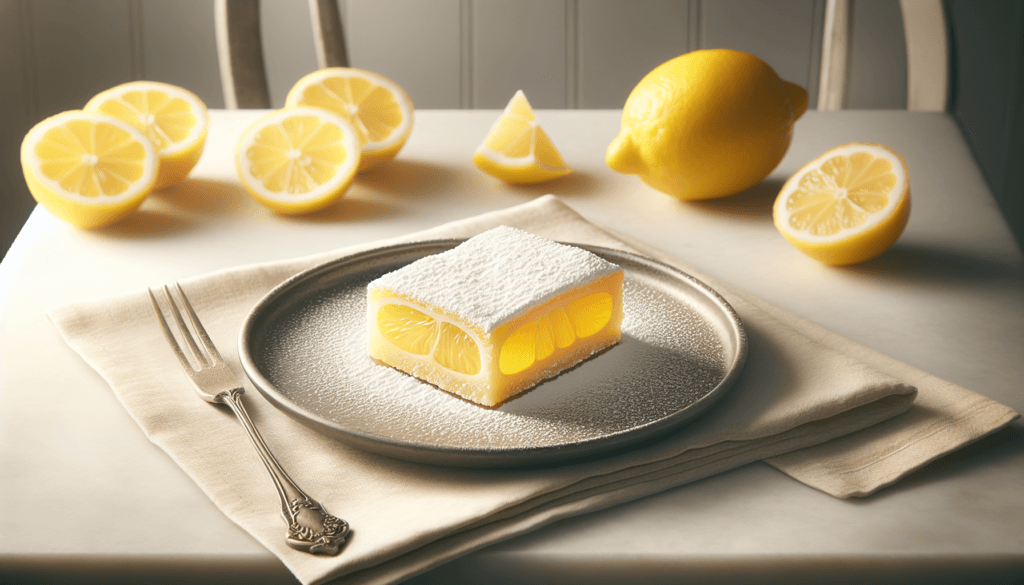You’re in for a treat with this article as it reveals the best ways to cook mouthwatering classic lemon bars coated with a generous sprinkle of powdered sugar. Whether you’re a seasoned baker or just starting out, these delightful treats are easy to make and bursting with tangy lemon flavor. We’ll guide you through step-by-step instructions to ensure your lemon bars turn out perfectly every time, leaving you and your taste buds begging for more. So grab your apron and get ready to create a delectable dessert that will impress everyone at your next gathering.

Choosing Ingredients
Selecting Fresh Lemons
When making lemon bars, it is crucial to choose fresh lemons that are plump, smooth, and bright yellow. The vibrant color indicates that the lemons are ripe and bursting with flavor. To ensure the best taste, give the lemons a gentle squeeze to ensure they are firm and not overly soft. Additionally, look for lemons with thin, smooth skin, as this makes zesting and juicing easier.
Using High-Quality Butter
Butter is an essential ingredient in creating a rich and flavorful crust for your lemon bars. Opt for high-quality unsalted butter, as it provides a great depth of flavor. Make sure the butter is at room temperature before using it in the crust. Softened butter will cream together more easily with the other ingredients, resulting in a tender and flaky crust.
Choosing the Right Flour
To achieve the perfect texture in your lemon bars, choosing the right flour is key. Use all-purpose flour for a balance between tenderness and structure. It has a moderate protein content that helps the crust hold its shape without becoming tough. Avoid using cake flour, as it may make the crust too delicate and crumbly. Stick to all-purpose flour for the best results.
Preparing the Crust
Gathering the Ingredients
Before starting the process of making the crust, gather all the necessary ingredients. This includes the flour, powdered sugar, salt, and unsalted butter. Having everything measured and readily available will make the whole process smoother and more enjoyable.
Mixing the Dough
To create a buttery and flaky crust, you must start by combining the dry ingredients in a mixing bowl. This includes the flour, powdered sugar, and a pinch of salt. Whisk the ingredients together until they are well combined. Then, add in the softened butter and use a pastry cutter or your fingers to cut the butter into the dry ingredients. The mixture should resemble coarse crumbs.
Pressing the Crust Into the Pan
Once the dough is mixed, transfer it to a greased baking pan or dish and press it down evenly with your hands or the back of a spoon. Make sure to press it firmly into the corners to ensure a consistent crust thickness throughout. Creating a compact and even layer will allow for a more stable base for the lemon filling and prevent the crust from crumbling after baking.

Creating the Lemon Filling
Zesting and Juicing the Lemons
Before juicing the lemons, make sure to zest them first. Zesting adds a bright and intense lemon flavor to the filling. Use a fine grater or microplane to remove the zest from the lemons, being careful not to include any bitter white pith. Once the lemons are zested, cut them in half and extract the juice. This can be done by hand or with a citrus juicer.
Whisking the Eggs and Sugar
In a separate bowl, whisk together the eggs and granulated sugar until well combined. The eggs provide structure to the filling, while the sugar adds sweetness and balances the tartness of the lemons. Whisk until the mixture becomes pale and slightly frothy, ensuring that the sugar is fully dissolved.
Incorporating the Lemon Juice and Zest
Once the eggs and sugar are whisked together, add in the freshly squeezed lemon juice and zest. Stir everything together until the mixture is smooth and well incorporated. The acidity of the lemon juice will react with the eggs, resulting in a thickened and custard-like filling. The vibrant lemon flavor will become the star of your lemon bars.
Baking the Lemon Bars
Preheating the Oven
Before baking your lemon bars, preheat your oven to the specified temperature in the recipe. Preheating ensures that the oven is at the correct temperature from the beginning, allowing for even baking and a consistent outcome. It is crucial to follow the recipe’s instructions regarding the baking temperature to achieve the desired results.
Pouring the Lemon Filling
Once the oven is preheated, carefully pour the prepared lemon filling over the prepared crust. Use a spatula or the back of a spoon to spread the filling evenly, ensuring that it reaches the corners of the pan. The filling should be thick enough to coat the back of a spoon without running off.
Baking to Perfection
Place the baking pan in the preheated oven and let the lemon bars bake until the filling is set and the crust turns golden brown. The exact baking time may vary depending on your oven, so it’s important to keep a close eye on the bars. They are done when the edges are slightly golden and the center no longer jiggles.

Cooling and Dusting with Powdered Sugar
Allowing the Bars to Cool
After removing the lemon bars from the oven, let them cool completely in the pan on a wire rack. Cooling allows the lemon filling to set fully and the crust to firm up. It’s essential to exercise patience, as cutting into the bars too soon can result in a messy and unstable texture.
Sifting and Sprinkling Powdered Sugar
Once the lemon bars have cooled completely, it’s time to add a finishing touch of sweetness. Sift powdered sugar over the top of the bars using a fine-mesh strainer to ensure a light and even coating. The powdered sugar not only adds a delightful visual appeal but also complements the tanginess of the lemon filling.
Cutting and Serving
Once the powdered sugar has been added, carefully lift the bars out of the pan using the edges of the parchment paper or a spatula. Place them on a cutting board and use a sharp knife to cut them into squares or rectangles. Serve the classic lemon bars on a platter, and they are ready to be enjoyed.
Adding Variations
Adding a Coconut Twist
To add a tropical twist to your classic lemon bars, consider incorporating coconut into the recipe. You can either add shredded coconut to the crust or sprinkle it on top of the lemon filling before baking. This variation will provide an added layer of texture and a hint of sweetness from the coconut.
Incorporating a Raspberry Swirl
For a burst of fruity flavor and vibrant color, incorporate a raspberry swirl into your lemon bars. Before pouring the lemon filling onto the crust, drop spoonfuls of raspberry puree on top. Use a knife or toothpick to gently swirl the raspberry puree into the lemon filling, creating a marbled effect.
Infusing with Lavender Flavor
For an elegant twist on classic lemon bars, infuse the lemon filling with subtle hints of lavender. Add a tablespoon of dried culinary lavender to the lemon juice during the zesting and juicing step. Allow the mixture to sit for a few minutes to infuse the flavors before whisking in the other ingredients. The delicate floral notes will elevate the lemon bars to a new level of sophistication.

Storage Tips and Tricks
Storing at Room Temperature
If planning to consume the lemon bars within a day or two, you can store them at room temperature in an airtight container or tightly wrapped in plastic wrap. However, make sure to keep them away from direct sunlight or heat sources, as this can cause them to become sticky or lose their freshness.
Refrigerating to Extend Shelf Life
For longer storage, refrigerate the lemon bars in an airtight container. This will keep them fresh for up to a week, and the chilled bars can be enjoyed straight from the refrigerator for a refreshing treat. However, note that refrigeration may slightly alter the texture, making the crust slightly softer.
Freezing for Future Enjoyment
If you want to savor your lemon bars at a later time, freezing them is a great option. Once cut and dusted with powdered sugar, arrange the bars in a single layer on a baking sheet. Place the sheet in the freezer until the bars are frozen solid, then transfer them to a freezer-safe container or bag. Lemon bars can be frozen for up to three months, and thawed at room temperature before serving.
Serving Suggestions
Pairing with Fresh Berries
Take your lemon bars to the next level by serving them with a side of fresh summer berries such as strawberries, raspberries, or blueberries. The tartness of the berries complements the sweet and tangy flavors of the lemon bars, creating a refreshing and balanced dessert.
Accompanying with Whipped Cream
For a creamy and luxurious touch, serve your lemon bars with a dollop of freshly whipped cream. The light and airy texture of the whipped cream adds a delightful contrast to the dense and tangy lemon filling. It’s a perfect pairing that will certainly impress your taste buds.
Serving as a Sweet Treat for Gatherings
Lemon bars are a crowd-pleasing dessert that can be easily prepared for gatherings and special occasions. Cut the bars into bite-sized pieces and arrange them on a platter for a beautiful and inviting dessert table. Whether it’s a birthday party, picnic, or potluck, these classic lemon bars will be a hit with everyone.

Tips for Success
Using a Microplane for Zesting
To achieve the finest and most flavorful zest, use a microplane or fine grater to zest your lemons. These tools create delicate strands of zest without grating the bitter white pith. The fresh zest will infuse the lemon filling with a robust and bright citrus flavor.
Lining the Pan with Parchment Paper
To easily remove the lemon bars from the baking pan and ensure clean slices, line the pan with parchment paper before pressing in the crust. Leaving some overhang will create handles for easy lifting. The parchment paper prevents the crust from sticking to the pan, making clean-up a breeze as well.
Avoiding Overbaking the Crust
Pay close attention to the baking time of the crust. Overbaking can result in a dry and tough crust, detracting from the luscious lemon filling. Once the edges turn a light golden brown and the center is set, it’s time to remove the pan from the oven. Remember that the crust will continue to cook slightly as it cools, so err on the side of slightly underbaking rather than overbaking.
Troubleshooting Common Issues
Soggy Crust
If your crust turns out soggy instead of crisp and golden, there might be excess moisture in the crust or the pan. Make sure to press the crust firmly into the pan, removing any air pockets. Additionally, checking the oven temperature and baking the crust for the recommended time can prevent a soggy crust.
Cracking Lemon Filling
A cracked lemon filling can be attributed to overbaking or sudden temperature changes. To prevent this, make sure to bake the bars until the filling is set but still slightly jiggly in the center. Also, allow the bars to cool gradually to room temperature instead of exposing them to a drastic change in temperature.
Uneven Texture
If your lemon bars have an uneven texture, there might have been too much stirring or beating of the lemon filling. Mix the ingredients until just combined to avoid overmixing, which can result in a denser and less tender texture. Gentle and minimal mixing helps maintain the creamy and smooth consistency of the filling.


